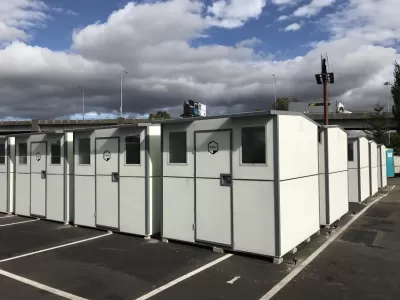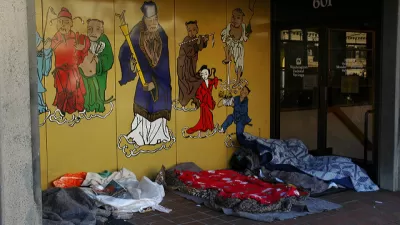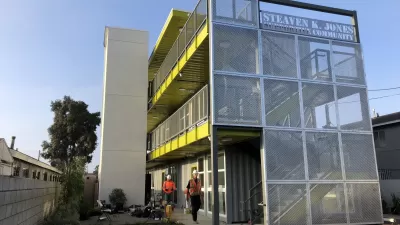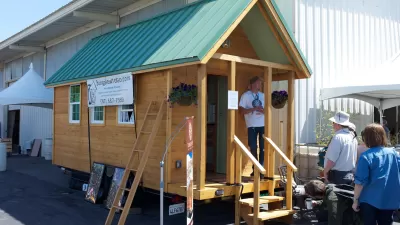Structures initially intended to temporarily house disaster victims are serving a new purpose in Tacoma, Washington—sheltering homeless people and getting them on the path to more permanent housing.

Tacoma, Washington, wanted to provide temporary shelter to homeless people that would be step up from the tent housing the city had offered as part of an effort to address the area’s homelessness crisis. The city started using tiny houses that originally were designed as emergency shelter for disaster victims, reports Hallie Golden:
Created by Pallet, based in nearby Everett, Washington, the small, white rectangular structures are covered from floor to ceiling with a fiberglass material and aluminum framing, and—depending on whether you pick the 64- or 100-square-foot model—can be set up with little to no tools in under an hour. They come with a fold-up bed, windows, a ventilation system, and a front door that locks. In other words, they are an "Ikea approach to shelter," says Amy King, the company’s owner and founder.
The shelters are now used as part of the process in transitioning people off the streets and eventually into more long-term housing. Other cities struggling with similar homelessness crises have expressed interest in using the Pallet structures because they are less expensive and easier and faster to erect than permanent structures.
"[Seattle Council’s Teresa Mosqueda] said she would like to see funding in this year’s budget go to these structures, as long as it’s coupled with supportive services, such as case managers, and funding for more long-term housing," notes Golden.
FULL STORY: These easy-to-build shelters are helping cities quickly provide cover to the homeless

Study: Maui’s Plan to Convert Vacation Rentals to Long-Term Housing Could Cause Nearly $1 Billion Economic Loss
The plan would reduce visitor accommodation by 25,% resulting in 1,900 jobs lost.

North Texas Transit Leaders Tout Benefits of TOD for Growing Region
At a summit focused on transit-oriented development, policymakers discussed how North Texas’ expanded light rail system can serve as a tool for economic growth.

Why Should We Subsidize Public Transportation?
Many public transit agencies face financial stress due to rising costs, declining fare revenue, and declining subsidies. Transit advocates must provide a strong business case for increasing public transit funding.

How Community Science Connects People, Parks, and Biodiversity
Community science engages people of all backgrounds in documenting local biodiversity, strengthening connections to nature, and contributing to global efforts like the City Nature Challenge to build a more inclusive and resilient future.

Alabama: Trump Terminates Settlements for Black Communities Harmed By Raw Sewage
Trump deemed the landmark civil rights agreement “illegal DEI and environmental justice policy.”

Dear Tesla Driver: “It’s not You, It’s Him.”
Amidst a booming bumper sticker industry, one writer offers solace to those asking, “Does this car make me look fascist?”
Urban Design for Planners 1: Software Tools
This six-course series explores essential urban design concepts using open source software and equips planners with the tools they need to participate fully in the urban design process.
Planning for Universal Design
Learn the tools for implementing Universal Design in planning regulations.
City of Santa Clarita
Ascent Environmental
Institute for Housing and Urban Development Studies (IHS)
City of Grandview
Harvard GSD Executive Education
Toledo-Lucas County Plan Commissions
Salt Lake City
NYU Wagner Graduate School of Public Service





























